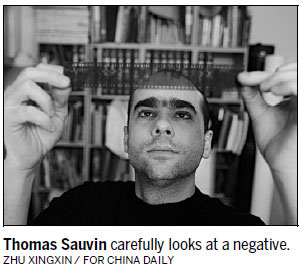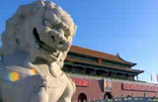Through negatives, Frenchman brings 80s and 90s China back to life
Updated: 2015-02-24 07:46
By Wang Qingyun(China Daily)
|
|||||||||||
Women in dresses pose by refrigerators, tourists on the beach stand with the sun setting behind them and children hug a statue of Ronald McDonald.
These photos of Chinese people taken in the 80s and 90s seem like any other nostalgic holiday snaps, until Thomas Sauvin sorted, exhibited and shared them online.
The 32-year-old Frenchman who lives in Beijing has salvaged and archived discarded negatives since 2009, for his project called Beijing Silvermine.
"Negatives are something people tend to neglect, as they easily think of them as just a tool that lies between a camera and a picture. I thought it would be interesting to archive negatives," he says.
Sauvin buys discarded negatives from a man who recycles trash including discarded negatives and X-ray films.
The pair found each other online after Sauvin posted messages that said he was looking to buy kilograms of negatives. The two met in a recycling workshop near Beijing's Northern Fifth Ring Road.
"I found he had been collecting discarded negatives for 15 years. But all the negatives ended up destroyed," says Sauvin, who later persuaded the man to sell him the negatives.
Sauvin examined the negatives, picked out what he thought was interesting and scanned them into images.

He told China Daily that he has more than 600,000 pictures in his collection and that he exhibited about 100 of them.
The exhibited pictures include those that feature women dressed in 1980s or 1990s fashions posing by refrigerators, which make up one of Sauvin's 40 series. Other series include people posing with television sets and tourists standing in front of oil paintings in museums.
The sizes of the series vary, with the women and refrigerators collection containing about 100 pictures, according to Sauvin.
Most of his collection comprises color negatives with snapshots taken from 1985 to 2005. The Beijing Silvermine project focuses on photos taken by ordinary Chinese people using film cameras since the nation's reform and opening-up, he said.
"About 25 to 30 percent of the negatives show the date when the picture was taken. Otherwise you can guess the time from a calendar or a building under construction in the background," Sauvin says. "Also, 1985 was the year when film cameras became widely used in China, and the year 2005 was when digital cameras started to take over."
Sauvin exhibited part of his collection in a photo festival in Lianzhou, Guangdong province in 2013 and won an "excellent curator" award.
The exhibition also went to Singapore, Britain, the United States, Australia, Switzerland and Belgium, he says.
Sauvin continued to dig into his collection for inspiration and compiled an album featuring scenes from wedding banquets, where newly wed couples were shown lighting cigarettes for guests or playing games with them.
"I found this interesting because for foreigners, weddings and smoking are two completely different things," he says. Sauvin added that the album was due to be published before May.
The Frenchman has spent most of the past 12 years in Beijing and said the project is a history book about, and written by, individual ordinary Chinese people.
"Foreigners tend to have radical - either good or bad - stereotypes about China. Many may think that China is completely different from their countries. But these photos show that the life we share is more or less the same, even though we have different challenges. We all give birth to babies, love our kids, fall in love, go to work, go to the beach, and go traveling," he says.
Contact the writer at wangqingyun@chinadaily.com.cn
(China Daily 02/24/2015 page5)
Today's Top News
Debate rages over color of dress photoed in rare light
Russia, China help stabilize global situation
Austria sees record number of tourists in January
Ukraine starts heavy weapons withdrawal
Greek new govt welcomes Chinese investment
Prince William starts Japan tour
Volvo Group stalls in Q4 as construction sector contracts
British deputy PM hosts Chinese New Year Reception
Hot Topics
Lunar probe , China growth forecasts, Emission rules get tougher, China seen through 'colored lens', International board,
Editor's Picks

|

|

|

|

|

|





